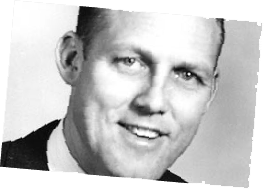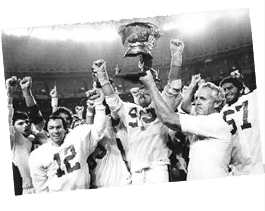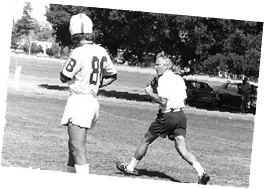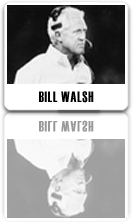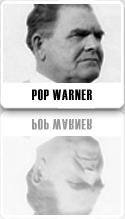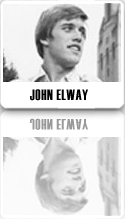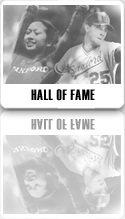
Walsh, one of only 21 coaches enshrined in the Pro Football Hall of Fame, and the only one nicknamed "The Genius." He was known for his revolutionary offense, "cerebral practice regimens" and keen eye for talent, among many other things.
"Bill was blessed with one of the greatest gifts you can have, which is the ability to see the future potential of another human being. It just so happened that football was his expertise," Hall of Fame quarterback Steve Young said in a recent interview. "He saw in me much more than I ever saw in myself, well before I ever had a chance to understand it. That is the ultimate compliment to the word 'coach.' There's nothing more a coach should be than to see the full potential of a player unfold. I am eternally grateful to Bill Walsh."
At Stanford, three generations of student-athletes called Walsh "coach." He served as an assistant coach in the mid-1960s, and as head coach in the late 1970s and again in the early 1990s.
"Like the rest of the world, Stanford knew Bill Walsh as a great coach," said university President John Hennessy. "But we also knew him as much more than that: a true leader to his colleagues and a role model for the young men and women he worked with. His loyalty to Stanford was absolute, and he returned again and again to support the university long after he moved beyond his head coaching duties. Stanford is forutnate that he chose to give so much to the university and we will long remember his integrity, dedication and sense of values."
Walsh will be remembered as one of the greatest offensive minds in football history, particularly when it came to tutoring quarterbacks. He coached three Hall of Famers--Dan Fouts, Joe Montana, and Steve Young--as well as former Cincinnati All Pro Ken Anderson.
At Stanford, the novel offensive strategies that would later come to be known and the "West Coast" offense originated as the "dink an dunk" offense, said former Cardinal quarterback Steve Dils, '78, who played for Walsh in 1977 and 1978.
Dils said Walsh emphasized the positive--what players could do to get better--instead of dwelling on what they were doing wrong. Still, Walsh was an exacting coach.
Dils said many coaches cared only if a quarterback completed a pass during practice--not how they did it. That wasn't good enough for Walsh, who scrutinized every aspect of a throw--timing, body mechanics, footwork, trajectory--and made Dils run the pass pattern five or six times until it was perfect, then said, "OK, that's right, now do it again."
Dils, who later played professional football in Minnesota, Los Angeles and Atlanta, said he played for some very good coaches. But none compared to Walsh.
"I learned more in two years from Bill about being a quarterback than I did in the rest of my 10 years in the NFL," said Dils, who now works in Atlanta for Grubb & Ellis, a commercial real estate advisory firm. "He taught me so much about the game."
In 1978, in a column in the San Francisco Examiner about the Stanford team, Frank Blackman described Walsh as the "life of the party" on the football field.
"His Stanford team, and the teams he directed as offensive coordinator in the pros at Cincinnati and San Diego, all have one thing in common," he wrote. "They're fun to watch."
It was a winning strategy for Walsh, who led Stanford to two bowl victories--the Sun Bowl in 1977 and the Bluebonnet Bowl in 1978.
The following year he left Stanford for an opportunity he had long coveted--head coach of an NFL team. In thi scase, he took over the then-woeful San Francisco 49ers and orchestrated one of the greatest success stories in the history of professional sports. In 1979, he took over a team that went 2-14 the previous season and transformed it into a Super Bowl champion in just three seasons. Under Walsh's direction, the 49ers won three Super Bowl titles (1982, 1985 and 1989), made seven NFC postseason appearances and claimed NFC West Division Championships. He was twice named NFL Coach of the Year (1981, 1984) and was later named NFL Coach of the Decade for the 1980s. He rsigned as head coach in 1989.
Aside from transforming the 49ers into one of the NFL's most dominant teams, Walsh was equally influential and innovative off the field. In 1987, Walsh launched the first minority coaching fellowship program to create more opportunities for minority coaches. The first two participants were Jerry Brown and Tyrone Willingham, now the head coach of the University of Washington. Marvin Lewis, head coach of the Cincinnati Bengals, was selected by Walsh as a coaching fellow the following year in 1988. The league later implemented the program with all of its teams.
For a time, Walsh worked as a football analyst for NBC. But he couldn't stay off the field for long. In 1992, he returned to Stanford as head football coach. Lowell Cohn, author of the 1994 book Rough Magic: Bill Walsh's Return to Stanford Football, compared the press conference in Burnham Pavilion to a coronation of the blue-eyed, white-haired Walsh, who was cheered by 600 people--fans, alumni and staff--and more than six dozen reporters from around the country.
During the 1992 season, Walsh began teaching a course on sports business management with Professor George Foster at the Stanford Graduate School of Business. In 2003, Walsh, Foster, and former Stanford wide receiver Gene Washington combined to create the annual NFL-Stanford Executive Education Program, designed to develop and deepen the core business skills of league executives. Later, with a Harvard professor, Walsh and Foster wrote The Business of Sports: Cases and Text on Strategy and Management, published in 2005.
Walsh rejoined the Stanford Department of Athletics in early 2004 as special assistant to the athletic director, a position he held until his death--first under Leland, then Robert Bowlsby. Walsh helped with fundraising, gave coaching seminars and helped recruit athletes.
His reach in college athletics had extended beyond Stanford in recent years. In 2004 Walsh helped restore strength to the San Jose State University athletic department and football program by leading the committee to hire Thomas Bowen as director of athletics. Less than a month later he recruited Dick Tomey to become head football coach. Tomey has turned the mortibund program into a winner, posting a 9-4 record and New Mexico Bowl crown in 2006. It was the university's first bowl game appearance in 17 years.
Walsh shared the secrets of his coaching philosophy and winning strategies in books. In 1990, he teamed up with sportswriter Glenn Dickey to write Building a Champion: On Football and the Making of the 49ers.
